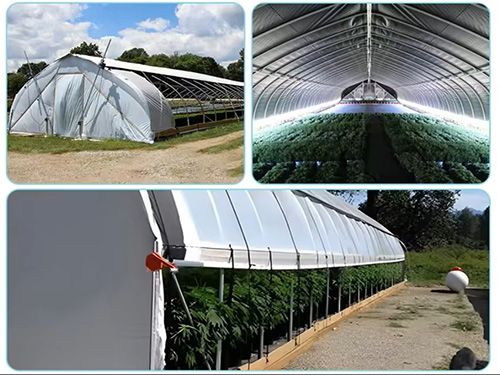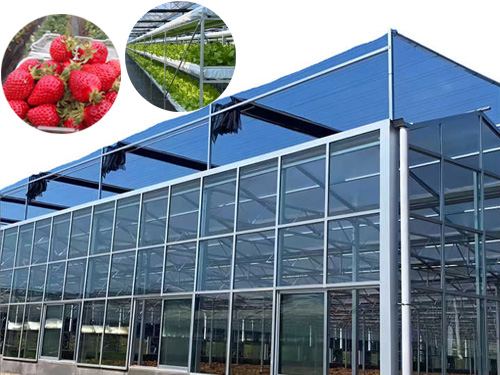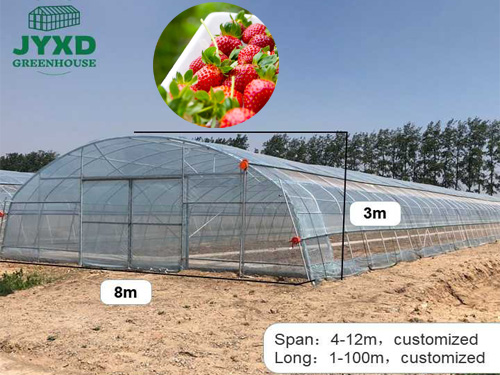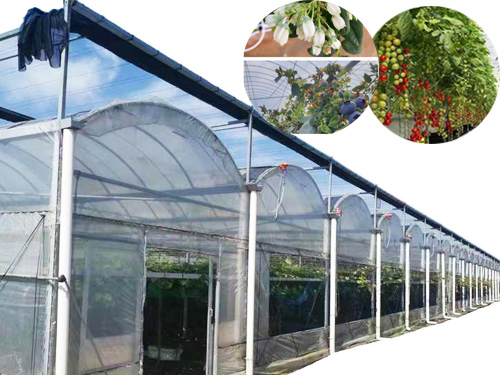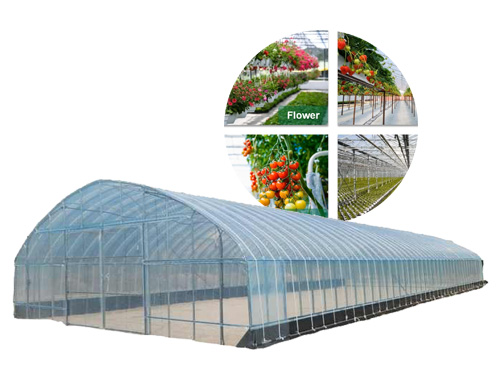NEWS DETAILS
NEWS INFORMATION
Improving Greenhouse Soil Fertility: Practical Soil Enhancement Tips
AUTHOR:jyxd-greenhouse DATE:2025-01-27 00:17:14 HITS:109
Soil fertility plays a pivotal role in the success of greenhouse farming. The health of the soil directly affects the growth, yield, and quality of crops. However, maintaining optimal soil fertility in a greenhouse can be challenging due to factors such as limited soil volume, nutrient depletion, and moisture imbalances. This article explores practical soil enhancement tips to improve soil fertility in greenhouses, ensuring healthier plants and higher yields.
Understanding Soil Fertility in Greenhouses
Soil fertility refers to the ability of soil to provide essential nutrients to plants. In a greenhouse, managing soil fertility is vital because the soil environment is often more controlled than in traditional farming, which means nutrients can deplete faster and the soil may need more frequent replenishment. Key nutrients like nitrogen, phosphorus, potassium, and micronutrients are essential for plant growth, and their availability must be regularly monitored and managed.
1. Nutrient Balance
Plants need a balanced mix of nutrients to grow. Excessive or insufficient levels of certain nutrients can hinder growth and lead to deficiencies or toxicity. In a greenhouse, it is important to test the soil regularly to assess nutrient levels and adjust accordingly.
2. Soil pH
The pH level of the soil affects nutrient availability. Most plants prefer slightly acidic to neutral soil, typically between pH 6.0 and 7.0. Regularly testing and adjusting the soil pH is necessary to ensure that plants can access the full range of nutrients.
Soil Enhancement Techniques for Improved Fertility
Improving soil fertility in a greenhouse requires a combination of strategies that enhance nutrient content, structure, and microbial activity. Below are several practical techniques to enhance soil fertility:
1. Composting for Nutrient-Rich Soil
Composting is one of the most effective ways to improve soil fertility. Organic compost adds essential nutrients to the soil and improves its structure, promoting better water retention and drainage.
· Organic Matter: Composting introduces organic matter that helps bind soil particles together, improving soil structure and water retention. This is especially beneficial in sandy or clay-heavy soils.
· Microbial Activity: Composting encourages beneficial microorganisms that break down organic matter and make nutrients more available to plants.
· Nutrient Boost: Well-composted material adds nutrients such as nitrogen, phosphorus, and potassium to the soil, which are essential for plant health.
To make your own compost, use a mixture of plant residues, kitchen scraps, and other organic materials. Turn the compost regularly to ensure proper aeration and breakdown of organic matter.
2. Utilizing Organic Fertilizers
In addition to compost, using organic fertilizers is an excellent way to enhance soil fertility in greenhouses. Organic fertilizers release nutrients slowly, reducing the risk of over-fertilization and nutrient leaching.
· Animal Manure: Manure from cows, chickens, or horses can enrich the soil with essential nutrients. However, it must be composted before use to avoid burning plants and to eliminate pathogens.
· Fish Emulsion and Seaweed: These fertilizers are rich in trace minerals, which help improve soil health and stimulate plant growth. Fish emulsion is particularly high in nitrogen, which is vital for leafy growth.
· Bone Meal and Blood Meal: Bone meal is a good source of phosphorus, while blood meal is rich in nitrogen. These can be used to correct specific nutrient deficiencies.
Organic fertilizers help improve long-term soil health by boosting microbial populations and encouraging a healthy, sustainable growing environment.
3. Crop Rotation and Cover Cropping
Crop rotation and cover cropping are time-tested techniques for maintaining soil fertility. Both methods prevent nutrient depletion and enhance soil structure.
· Crop Rotation: Rotating crops ensures that different plants do not exhaust the same nutrients year after year. For example, nitrogen-fixing plants like legumes can be rotated with crops that require more nitrogen, reducing the need for synthetic fertilizers.
· Cover Cropping: Growing cover crops, such as clover or vetch, during the off-season can help maintain soil fertility. These crops fix nitrogen in the soil, and their decaying roots add organic matter, improving soil texture and nutrient content.
Both crop rotation and cover cropping are sustainable ways to enhance soil fertility without relying on external fertilizers.
4. Adding Soil Amendments
Soil amendments help improve soil texture and fertility. These substances can alter soil pH, improve drainage, and provide essential nutrients.
· Lime: If your soil is too acidic (low pH), adding lime can help raise the pH to a more neutral level. This ensures that plants can access nutrients more easily.
· Sulfur: For alkaline soils (high pH), sulfur can be added to lower the pH, making the soil more suitable for a wider range of plants.
· Biochar: Biochar is a form of charcoal that can be mixed into the soil to improve its structure, water-holding capacity, and nutrient retention.
Using the right soil amendments can correct specific deficiencies and improve overall soil health in your greenhouse.
5. Maintaining Proper Irrigation Practices
Water management is closely linked to soil fertility. Over-watering or under-watering can leach away nutrients or deprive plants of necessary moisture.
· Drip Irrigation: Drip irrigation delivers water directly to the roots of plants, minimizing water waste and preventing the soil from becoming too soggy or compacted. This ensures that nutrients remain in the root zone where they are needed most.
· Water Quality: The quality of the water used in the greenhouse is also important. High mineral content in water can lead to nutrient imbalances and affect plant growth. Regularly test water quality to ensure it supports healthy soil and plant development.
By using efficient irrigation practices, you can maintain consistent soil moisture levels and prevent nutrient loss from excessive runoff or evaporation.
Monitoring Soil Fertility and Making Adjustments
To ensure continued soil fertility, regular monitoring and adjustments are necessary. Testing the soil for nutrient levels, pH, and organic matter content can help you determine when and how to add fertilizers or amend the soil.
1. Soil Testing
Regular soil testing is the first step in understanding your soil's fertility. A soil test will reveal the levels of macronutrients like nitrogen, phosphorus, and potassium, as well as micronutrients such as calcium, magnesium, and sulfur. It will also provide an accurate pH reading, helping you determine whether amendments like lime or sulfur are needed.
2. Adjusting Fertilization Based on Needs
Based on soil test results, you can adjust your fertilization practices. If certain nutrients are lacking, specific organic or synthetic fertilizers can be applied to address deficiencies. Regularly revisiting this process ensures that your greenhouse soil remains fertile and conducive to healthy plant growth.
Conclusion
Improving greenhouse soil fertility is a continuous process that requires careful management of organic matter, nutrients, irrigation, and soil amendments. By implementing strategies such as composting, using organic fertilizers, practicing crop rotation, and monitoring soil health, you can create a thriving growing environment that supports healthy crops and high yields. Healthy, fertile soil is the foundation of successful greenhouse farming, and with the right practices, you can ensure long-term sustainability and productivity.
Hebei Juyou Xinda Greenhouse Facilities Co.,Ltd.
Copyright © 2024-2025 https://www.jyxd-greenhouse.com. All Rights Reserved Hebei Juyou Xinda Greenhouse Facilities Co.,Ltd.Copyright





 Current Location:
Current Location:


